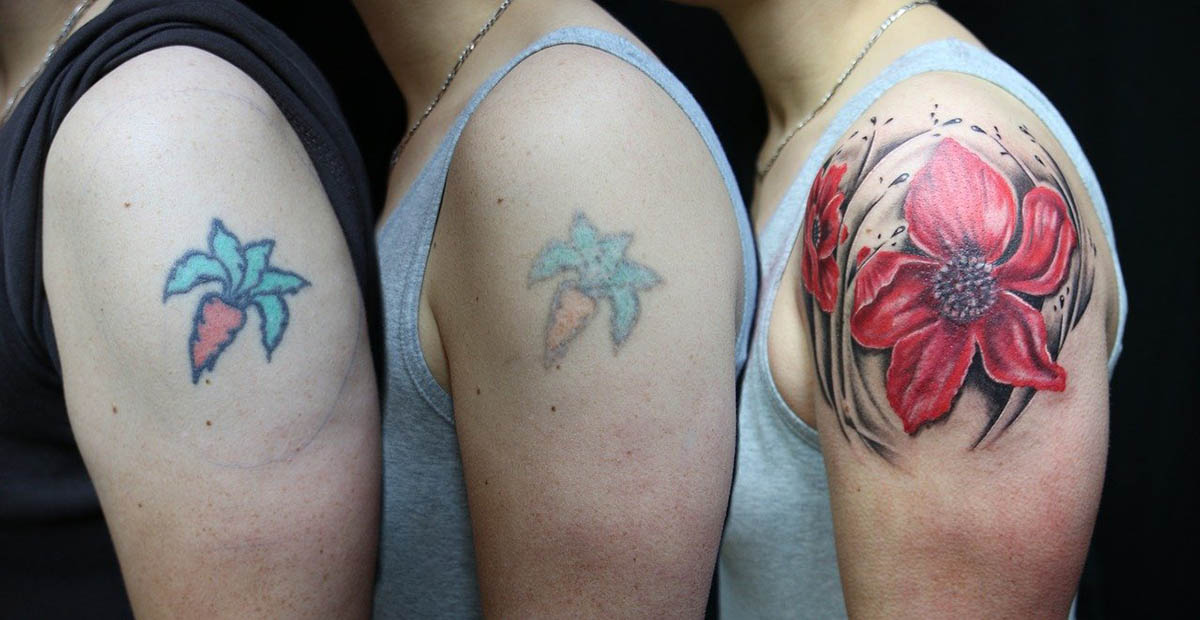Getting a tattoo is a special event with lifelong consequences. You choose the model, you get excited about where the tattoo will be, you suffer all the pain, and then you enjoy it and show it with pride. Or maybe not.
Sometimes tattoos may turn out to be indelible traces of our momentary foolishness or an ugly sign of the inexperienced tattoo artist. Whatever is the reason you don’t like the tattoo, you probably really want to remove it as easily as you did it.
Recent developments in body scar removal equipment, including tattoos, are beginning to approach this dream – to erase easily and almost painlessly stretch marks, acne scars, and tattoos without risk of scarring. Laser treatment can be highly effective in helping you deal with your tattoo regret.
Table of Contents
How to remove your tattoo?

To apply the permanent pattern of your choice on your skin, a tattoo artist uses an electric needle machine that injects ink pigments into your skin through rapid and repetitive penetrations. The smoother a tattoo ink is, the easier it is to remove, as the entire pigment is in one layer.
Since the 1980s, lasers have been the most preferred tattoo removal method. The laser is a beam of high-intensity, monochromatic light and provides a bloodless, low-risk, and effective method for erasing tattoos with minimal side effects. The removal procedure is a series of treatment sessions. The tattoo ink is broken down into tiny particles, which with time are cleared by the immune system.
The type of laser which is going to be used depends on the colours of the tattoo. Monochrome tattoos are the easiest, and if you are preparing to get one of these, you should know that the most difficult to remove are the yellow and green pigment, and the easiest – the blue and black.
In fact, the laser removes the ink by sending short signals of intense light, which passes harmlessly through the top layer of skin and reaches the ink. The energy that is created breaks down the pigment into tiny particles, which are then absorbed and cleared by the immune system. The healthier, hydrated, and rested a person is, the faster his immune system will be able to destroy the pigment particles. To remove a medium-sized tattoo you may need several laser procedures.
How is the laser treatment performed?
As we said, the tattoo laser removal is based on the property of light pulses – they can selectively affect the pigment substances. Due to the wavelength and frequency of the emitted beam, without damaging the surface layer of the skin, the dye located in the epidermal and dermal layer of the skin, is broken down into microparticles. The molecular structure of the dye is destroyed and it discolours and gradually (within 3-4 weeks) is washed from the skin through the lymph. This method for tattoo removal, which does not damage the healthy skin around the pigment, has been the ‘gold standard’ for a long time. With the help of the laser can be successfully removed not only decorative but also traumatic tattoos, as well as permanent makeup on the eyebrows and lips.
The procedure takes between 15 to 30 minutes, depending on the tattoo size. Anaesthesia is normally not required. The course of treatments may vary from 2 to 4+ procedures, depending on the colour of the pigment and its depth in the skin.
Types of tattoo removal lasers
People are often confused about different types of lasers and different brands on the market. The lasers for tattoo removal are two types – Q-switched lasers and Pico lasers. Pico laser or Picosecond laser is more advanced and modern technology compared to a traditional Q-switched laser.
Q-switched laser
It has 3 wavelengths:
- 532 nm – this wavelength creates red light that is easily absorbed by the green and dark colors of tattoos. It is perfect for removing blue ink;
- Q-switch Ruby: 694 nm – It is similar to 532. This type of laser has a high absorption of melanin and it also has a good effect in the treatment of pigmentation changes in patients with white skin;
- Q-switch Nd: Yag: 1064 nm – this length creates light similar to infrared and it is absorbed by all dark pigments of the ink. Therefore, it is suitable for removing tattoos in black, brown, grey, navy blue colours. This type is more suitable for people with dark skin because the wavelength is poorly absorbed by melanin.
The combination of these wavelengths in Q-switch mode makes it possible to remove tattoos of different colours.
Pico Laser
The Picosecond tattoo removal laser is the most modern new generation technology. It uses trillions of second powerful laser energy that shred the pigment in the skin tissue. As a result, the tattoo and pigment are completely removed. The laser can be safely used in all skin types.
Through a specialized Pico fractional lens, a second laser can convert the laser energy into gentle pressure to create new collagen by squeezing cells and activating the natural cell without burning or damaging the skin.
- 532 nm can remove brown spots, red colour tattoo, vascular lesions, and so on. This wavelength can be effective for warm-toned colours such as red, violet, yellow, brown, and so on.
- 585 nm can remove surface pigments, such as a birthmark, brown spots, red tattoos, and vascular lesions. It is more suitable for dark skin colour.
- 650nm can remove tattoos in green and blue colours.
- 1064nm can remove the dermal layer pigment in the face and body, such as a birthmark. This is perfect for removing dark and black tattoos.
How do you take care of the skin after tattoo removal with a laser?
Keep the treated zone clean and dry for the next few days. It should not be exposed to direct sunlight and therefore it is not recommended to treat your tattoo in the summer. Autumn and winter are the most suitable because then the body is mostly covered with clothes.
The doctor will give you special instructions on how to take care of the treated zone. Each case needs different aftercare.
Benefits of Pico Laser tattoo removal
- It has high efficiency;
- It is safe;
- It is a non-invasive procedure;
- Picosecond laser removes tattoos without traces and scars;
- It is a painless technique;
- The period of tattoo removal is shorter which reduces the risk of thermal skin damage.
How much does tattoo removal cost in Singapore?

There are many factors that affect the cost of laser tattoo removal in Singapore- things like how big is the tattoo, how many colours does the tattoo have, who is providing the treatment, the quality of equipment you are being on will also affect the cost. Oftentimes people will treat you with a laser that’s very cheap and ineffective and doesn’t really provide outstanding results. That’s why it is important to carefully choose the clinic where you will remove your tattoo.
Pico treatments in Singapore, particularly when used for laser tattoo removal, typically are going to range on the higher end. So when you look at the typical range per session you go from the low end – $250 per session, to sessions that can be high as $1000 – for something that’s considered in essence an extra-large tattoo. In generally speaking it is important to know that typical tattoos need between five and ten sessions with great equipment.
Other common questions
Can you remove all colours of the tattoo?
The 1064 nm wavelength is used to remove black, brown, grey, and dark blue tattoos (dark colours), and the 532 nm wavelength is used to remove green and red tattoos. Not all dyes are susceptible to destruction. Discolouration of yellow, white, and light blue dye is less effective. However, Picosecond lasers may have very good results for all colours.
Is one procedure enough?
Tattoos are not discoloured with a single procedure. With each procedure, the colourants react in layers – from the most superficial to the deeper ones and gradually the colour of the tattoo fades. The number of procedures depends on the quality of the dye, the patient’s skin type, the location of the tattoo, the amount of ink whether there is any scarring, or any tattoo on top of the tattoo, etc. As the tattoo removal treatment progress, the original tattoo will be visible but fading with each subsequent session.
What is the interval between procedures?
The time required for resorption and disposal of the crushed pigment particles is at least 6 weeks.
Is there any pain during the procedure?
The tattoo removal procedure cannot be described as completely painless for patients. It involves some level of pain but it is minimall. Many of the patients describe it as more comfortable than applying the tattoo. By using advanced technology like laser tattoo removal, it can be done safely with minimal discomfort and faster healing than has been experienced with traditional procedures.
Is there a good type of tattoo that can be removed or are there different colours that make a difference?
The darker the colour is the easier it is to remove. Although lasers have different heads so one of the heads will remove the dark, red, purple, blue, and black colours, and the other head uses a shorter wavelength and will help with the paler colours, blue, green, brown, orange.
To conclude
Laser happens to be the gold standard for tattoo removal. There are other methods like topical creams, microdermabrasion, injecting, and isotonic solutions but they are not really helpful and also can mess up your skin. The laser is considered one of the most effective tattoo removal methods.

